One point I will make about this wine – I tried it from two
glasses - a Riedel Restaurant Champagne and Riedel Vinum Riesling/Chianti. The Riesling/Chianti glass showed much stronger
coconut notes while the Champagne showed the minty notes to a
greater degree. Another winner from Vilmart. The price is
starting to get up there, but I still get excited about this
every year and it always shows excellent potential. It may not
be as long lived as some of the other Coeur’s, but it will age
and is a treat today. Grade of high B+
(88-90 pts) for today with A- (90-92 pts) potential. Find this wine
2006 Luigi Bosca Finca La Linda Sparkling Chardonnay/Semillon
Extra Brut
(Charmat Method; 50% Chardonnay,
50% Semillon; Mendoza, Argentina; 8.12 g/L dosage; 12% alc;
$11-15 US)
Light sunshine and sand in color, this wine has a nice mousse
and a very fruit forward nose. Aromas of orange, peach, and
sweet apricot waft up at me. While the nose is full of fruit and
has a sweetness to it, it still takes on a rather dry and clean
character. I say this so that you know this is fruity, but not
cloying, and is definitely asking to be taken seriously as a
sparkling wine. A fluffy mouthfeel leads into mineral and citrus
notes along with some bitterness and a touch of amylic peach.
Where the nose is a very nice fruit basket, the palate tries a
bit too hard to be something it is not (Champagne) and ends up
not coming out as well as it should or could have. Had this
played a bit more true to itself, I think you would have a fun filled sparkling fruit parade.
I haven’t had many Argentinean sparklers, but this is a decent
effort and better than most New World Charmat Method wines. More
than anything it seems like a cross between a Prosecco and a new
world wannabe-Champagne. If Argentina can learn to capture what
it does best and pay respect to Champagne, this could be a
region to watch for easy, fruity, early drinking, subtly
complex, great value sparklers. I also wonder how in the world
something with 8.12 g/L of residual sugar can be labeled Extra
Brut (Extra Brut is only 0-4 g/L of residual sugar). Does
Argentina have its own residual sugar chart? I may have been
tough on this bottle, but it does show what Argentina is capable
of. I now look forward to trying Luigi Bosca’s higher end
bottlings that are made via Methode Champenoise.
Grade of C+ (77-79 pts). Find this wine
NV Perrier-Jouet Grand Brut
(Approximately 35% Pinot Noir,
40% Pinot Meunier, 25% Chardonnay; Dosage 11.5 g/L; Disgorged
June 2003; $25-$35 US)
I’ve been fortunate to follow this disgorgement along for the
last 2.5 years and opened up my last bottle of it today. The
nose shows lots of floral citrus mixed with peach and rich,
creamy dough. Pinot Meunier can be found, but it seems to be
meshing perfectly and lifting the wine up. This is showing
wonderful balance for a big house NV wine right now. Citrus,
sweetness, earthiness, fruit, and dough notes all mesh
perfectly. Some slightly sweet citrus and young dough mingle
with a bit of earthy peach to accentuate the fluffy
medium-weight mouth feel of the wine. It finishes up with a good
dose of cream and a touch of light bitter citrus. I know it is a
mass production wine, but I like it and for an easy to find $25,
it is hard to beat in my book. Perrier-Jouet has been doing some
very nice things with their NV and basic vintage offerings
lately and this shows it. If you buy a young
bottle, let it age for a couple years and it will reward you.
This bottle has 3.5 years of post disgorgement age on it and
shows no signs of slowing down. I should have bought more.
Grade of low B+ (87 pts). Find this wine
2003 Gloria Ferrer Blanc de Blancs
(100% Chardonnay; Carneros
Valley, Sonoma, California; 12% alc; Disgorged 2006; $15-20 US)
A very fragrant nose gives off aromas of concentrated citrus,
light peach kisses, and a hint of fluffiness. It matches the
light color of this wine perfectly. In the mouth, this shows a
nice acidity that meshes with some lime spritzer water and
fluffy peaches. A dose of minerals and earth also sneaks in as
this rolls off to a light, lively, and slightly creamy finish.
It shows some similar characteristics to the Gloria Ferrer Sonoma
Brut and the Royal Cuvee and falls right in between the two
quality wise. It is a good step up from the Sonoma Brut in my
opinion, but nowhere near as good as the Royal Cuvee and a bit
behind the Blanc de Noirs as well. Another nice effort from
Gloria Ferrer. Grade of low B (82-84
pts). Find this wine
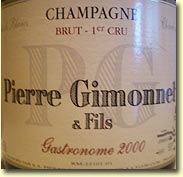 2000 Pierre Gimonnet Premier Cru Blanc de Blancs Gastronome
2000 Pierre Gimonnet Premier Cru Blanc de Blancs Gastronome
(100% Chardonnay; Dosage 8 g/L;
Cremant style of approximately 4 atm of pressure; Disgorged
March 29, 2006; $50-60 US)
Very pale in color and full of tart apples & pears, hints of
steel & minerals, and some light flowers on the nose. This wine
smells quite dry and the taste confirms this suspicion. I never
would have guessed a dosage of 8 g/L in this bad boy. It tastes
like it has seen a bit less or needs a bit more. As the acidity
is not overbearing, to me this signals weak fruit. And the fruit
is weak indeed. This just seems a bit too dry, very watery,
slightly salty, and a tad bitter to me. I do get some mineral
laced pear & apple notes, some smoky flint, and decent dose of
citrus, but a salty and bitter lemon pepper note also comes
through and really ruins the finish. This wine’s dry streak
bends toward the mineral side of things, but the fruit and
sweetness just aren’t strong enough to balance it out or cover
up the holes.
While it is drinkable, I find it average and not very good. I
know some who will shout “terroir” and “it is meant for food,”
but to me that is simply Champenois for “this wine is thin,
hollow, and not very good”. Still, I can recommend this wine. I
recommend you avoid it. Poor effort by Gimonnet and wasted cash
on my part. Grade of low C (73-74 pts). Find this wine
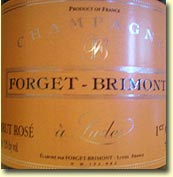 NV Forget-Brimont
Premier Cru Brut Rosé
NV Forget-Brimont
Premier Cru Brut Rosé
(Approximately 60% Pinot Noir, 20
% Pinot Meunier, 20 % Chardonnay; Base vintage of 2002; Red wine
addition, Disgorged 2006; $30-40 US)
This is deep and sappy, showing more dried fruit than fresh.
Cherry, strawberry, orange, and almond combined with the creamy
texture and fine mousse for an harmonious impression. Excellent
length.
Wine Spectator 2006: 91 Points!
 No, we’re not becoming Spectator pimps; we are only quoting the
back label of this bottle. I have never seen anything like this
before. The back label has the normal producer/importer
information along with the typical alcohol warning that I will
grow five legs and/or spontaneously combust if I get near a car
after having a glass, but it also has the strange Spectator
blurb shown above. I want to hate the wine because of the blurb,
but I figured I should taste it first.
No, we’re not becoming Spectator pimps; we are only quoting the
back label of this bottle. I have never seen anything like this
before. The back label has the normal producer/importer
information along with the typical alcohol warning that I will
grow five legs and/or spontaneously combust if I get near a car
after having a glass, but it also has the strange Spectator
blurb shown above. I want to hate the wine because of the blurb,
but I figured I should taste it first.
A rather pale, but bright almost florescent hot pink color
really grabs the eye. This wine sure does sparkle in the glass.
The smell is not too bad either as it gives off gentle aromas of
strawberries and cream. Earthy strawberries, tart cherries, and
fluffy, creamy lemon biscuit flavors come up to show that you
can’t judge a wine by its nose alone. While this has a
fluffy, sweet, creamy mouth feel, the fruit flavors add a
nice dimension of depth that helps to make this a wine to be
reckoned with. A long and mouth wetting creamy, gentle
strawberry and citrus finish adds to the package as well. Don’t
get me wrong, this isn’t a big Rosé, but isn’t a fruit bomb
either. It is fluffy, well structured, and full of tart, creamy,
red fruit. Some air time only does it better as it smoothes out
and takes on a silky, sweet, cherry & strawberry bread flavor. I
think a couple years of bottle age will only make this wine
better.
After reading the back label, I wanted to dislike it, but
I can’t. It is good stuff, an excellent value, and probably the
best wine that Forget-Brimont makes. My only suggestion is that
they drop the Wine Spectator stuff and quote the Gang of Pour
instead! Grade of low B+ (86-88 pts). Find this wine
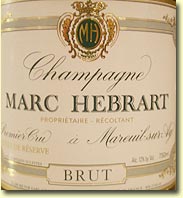 Marc Hebrart Premier Cru Cuvee de Reserve Brut
Marc Hebrart Premier Cru Cuvee de Reserve Brut
(80% Pinot Noir from Mareuil sur
Ay, Bisseuil, Avenay Val d’Or, 20% Chardonnay from Oiry,
Chouilly, Mareuil sur Ay ; Vintage makeup: 70% 2002, 15% 2001,
15% 2000; Average vine age of 24 years; Disgorged 6/15/2006;
Dosage 8 g/L; $25-35 US)
A very fragrant, slightly spicy floral aroma fades into fluffy
peach and orange scents mixed with some buckwheat biscuits.
These aromas kick the palate off quite nicely as a spicy and
zesty orange flavor meshes with light nutty dough notes. After
the first flavor wave, the wine fluffs up with some peach notes.
It then thins out as a clean mineral and chalk aspect comes in
and leads the way into a slightly bitter and chunky chalk laced
finish. This wine has many great points, but a few bad ones too.
It blasts out of the gate with flavor, but eventually falls
behind and doesn’t win the race. Still, for the price, it is not
a bad buy. If you are looking for a simple, elegant styled
bubbly that will not break the bank and shows some nice, dry
mineral and chalk notes along with a few bursts of citrus and
dough flavors then this may be a wine for you. It isn’t quite up
my alley as the Pinot doesn’t express itself as I like it too.
This is very mineral driven for the grape makeup. I also would
like to see a little less expression of chalk, but some do like
this sort of thing. Grade of B- (80-82
pts). Find this wine
 NV
Piper-Heidsieck Rosé Sauvage Brut
NV
Piper-Heidsieck Rosé Sauvage Brut
(Approximately 45% Pinot Noir,
40% Pinot Meunier, 15% Chardonay; Red Wine Addition; Disgorged ~
late 2005; $30-50 US)
This is an interesting wine as it is labeled as a Sauvage (which
normally means it is naturally raw/bone dry, sees no dosage, and
has a residual sugar level of less than 2 g/L), but it receives
a Brut dosage of 9-12 g/L. This can lead to some confusion, as
while the wine is dry (especially compared to what an average
non-wine drinker expects), it is not “bone dry.” Also, Piper
used to make a non-dosage cuvee that was called… Sauvage. I give
them credit from a marketing angle as the pink label and Sauvage
title balance both ends of the spectrum. It helps with the
wine’s shelf appeal with both men and women… even if it is
factually misleading.
This is a deep colored Rosé. It is not pink, but rather red in
color. As Ford Motor Company would say, it shows some bold
moves. The nose gives off aromas of dark cherry skins and orange
laced biscuits that lead me to believe that this will be a
serious wine to sit back and think deep thoughts about (despite
the bright pink label). Light and elegant bodied flavors of
cherry, strawberry, and ruby red grapefruit kick the palate off
and lead into a cloud of chalk dust laced with powdered sugar
for a touch of sweetness. Once the dust clears, a zinging fruit
punch spritzer-like acidity that seems just a tad out of place
comes to the fore. Dry fruit punch flavors, hints of tobacco
leaf, some tannins, and a touch of heat bring this wine home.
I have to admit that this has me scratching my head. I
can’t seem to put my finger on it, but something is slightly out
of balance. The dark, dry red fruit, chalk, tannins, and fruit
punch spritzer flavors just don’t seem to want to play together.
I think this wine has potential to be a very good buy, but it
just doesn’t deliver on all of that potential. I say give it a
go if it goes on sale for under $35 US, but otherwise there is
plenty of competition that I prefer.
Grade of high B- (82-83 pts). Find this wine
 1999 Chartogne-Taillet Millesime Brut
1999 Chartogne-Taillet Millesime Brut
(60% Pinot Noir, 40% Chardonnay;
Merfy; Malolactic only on the Pinot Noir; Dosage 9 g/L;
Disgorged April 2006; $45-65 US)
Fresh cut pears and bread dusted with chalk form the nose on
this gold kissed pale colored bubbly. The palate is very similar
to the nose as tons of pears join dough, fresh bread, and chalk
to form the core flavors. A slightly salty and slippery citrus
note plays hide and seek to close out the palate profile. For
the encore, a terrific slightly sweet and creamy citrus note
plays on and on, but it isn’t enough as most of the audience has
already left the building. Air time does lift this up, but it
never gets up high enough. This wine is very typical of the
basic Pinot/Chardonnay mix Chartogne-Taillet offerings. It is
good, but just seems too darn ordinary. I don’t dislike this
wine and I believe it will improve with some age, but it just
leaves me wanting…. for the wine below.
Grade of B- (82 pts) with low B potential
(84 pts) in 5 years. Find this wine
 1999 Chartogne-Taillet Fiacre
1999 Chartogne-Taillet Fiacre
(60% Chardonnay, 40% Pinot Noir;
Merfy; Disgorged April 2005; $50-80 US)
Fiacre is Chartogne-Taillet’s tete de cuvee from their oldest
vines and includes a large proportion of grapes grown from
ungrafted pre-phylloxera vines. It is identical in color to the
1999 Millesime above, but that is where the similarities end.
The Fiacre has a very feisty nose that gives off subtle notes of
sherry, biscuit, nuts, citrus, honey, and yeast. It has some
hardcore Pinot Noir screaming at me to take not a sip, but a big
‘ol gulp. The palate is much more subdued than the nose and
comes across with a gentle elegance that is very attractive.
Flavors of biscuit dough, honey, flowers, and a creamy, nutty
note play perfectly off of the mineral laced orange and young
pear backbone. A few hints of chalk show up and the finish is
once again long, sweet, and creamy, but outside of this house
signature, this wine is head and shoulders above the rest of
Chartogne-Taillet’s offerings (I only consistently like the
Fiacre and NV Blanc de Blancs). It just has some extra zip and
zestiness to it that I don’t get in their other cuvees. As a
point of interest for this wine, I see good potential for it to
improve with another 5-8 years in the bottle. As I sometime can
be rough on them, I must say, “Good job Chartogne-Taillet.”
For today, this gets a grade of B+ (87-88
pts) and I think it will become a low A- (90 pts) with some time
in the bottle. Find this wine
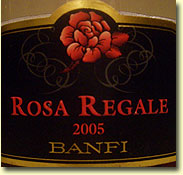 2005 Banfi Vigne Regali Rosa Regale Brachetto d’Acqui
2005 Banfi Vigne Regali Rosa Regale Brachetto d’Acqui
(100% Brachetto, Piemonte, Italy;
Red color achieved through maceration; 7% alc; $12-22 US)
Just in time for Valentine’s Day, I pulled a bottle for an early
romantic moment. This wine is a beautiful shade of ruby red and
has a wonderful foam to it that only adds to the appearance. So
as to how it actually performs… Sweet hard sugar rock candy
mixes with delicate red cherries and juicy strawberries to form
the nose. The palate is just as sweet with honey and nectar
mixing with some floral notes and wonderful juicy, sweet
strawberries and raspberries. As for the finish, it is a bit
short when compared to the rest of the wine, but it shows a nice
sweet red citrus twang.
I have to admit that this is a guilty pleasure of mine that I
love to drink within a year of purchase. After that, it tends to
lose some of its attractiveness. An easy frame of reference for
this wine is to look at it as a sort of Rosé version of Moscato
d’Asti. From experience, I can tell you that a hot tub loves
this too. A romantic pleaser that is perfect for Valentine’s Day
and a great match for dark chocolate. Also, it is only 7%
alcohol so you can drink it with abandon and not have to worry
about any, uh, later difficulties. I proudly admit that I like
this. Grade of B (85 pts). Find this wine
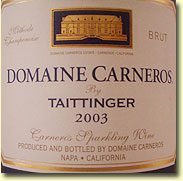 2003 Domaine Carneros Brut
2003 Domaine Carneros Brut
(68% Pinot Noir, 31% Chardonnay,
1% Pinot Blanc; Carneros, Napa, California; Dosage 12 g/L; 12.7%
alc; Disgorged ~ second half 2006; $20-25 US)
This is the latest release from one of my favorite California
sparkling wine houses. It has a nose of fragrant flowers,
peaches, light notes of spice, and a wonderful sweet fluffiness.
As with all of Domaine Carneros wines, this captures the feel of
California perfectly. Slice a juicy Bartlett pear, grab some
fresh slightly sweetened cookie dough, and open a jar each of
almond butter and orange marmalade. Now make a sandwich with the
ingredients and wash it all down with a slightly sweet and
bitter orange flavored mineral water. That is how this wine
tastes. It is a very nice effort that is slightly less creamy
than the 2002 and more mineral focused. This is ready to go now,
but can easily be kept for a year or two. For the price, it is a
very good value. Grade of B (84-85
pts). Find this wine
NV Cameron Hughes Lot 25 Napa Valley Carneros Sparkling Wine
(50% Chardonnay, 50% Pinot Noir;
100% 1998 vintage; Carneros, Napa, California; Disgorged ~ 2006;
6,000 cases; $20-25 US)
This wine has a very interesting story behind it. If you are not
familiar with Cameron Hughes wines, Cameron finds incredible
deals by selecting and buying high quality wine that for one
reason or another a winery doesn’t want (though he may also
eventually get into grape selection and having wine made for him
as well). It is kind of like finding a great deal on a house.
Maybe someone has to sell fast and take what they can get. If
you find the house at the right time, you can make a killer
deal. Cameron does this with wine. Most of the wines in the Lot
program retail for around $10-$12, but would be $30+ had they
hit the market from the original winery. The sparkling wine
reviewed above is his priciest release to date, but it was
originally going to retail for $50 a few years ago. So how can
Cameron get the wine out there so inexpensively? He cuts out the
wholesale and middle man and sells direct. A majority of his
sales are to Costco who also works on a small margin. The end
result is a great deal for the customer.
His website does a
great job explaining it all (and you can order direct from it
too).
Okay, so how does this sparkler taste? Well, it is a very good
wine. Initially, the nose jumps out at you with fluffy peaches,
pears and a nice citrus note that is benchmark Carneros
sparkling wine. With some time in the glass, it changes its
colors and comes up with aromas of the ripest pears I have ever
come across mixed with some pine and floral notes. The nose on
this wine is right up there with the best in California
sparklers. So how is the palate? Is it as good as the nose?
Well, the palate is good, but doesn’t quite walk the walk that
the nose does. Citrus, pear, and dough flavored with a small dab
of vanilla make up the core flavors, but they all just seem a
bit too thin for my liking. The finish is also a bit of a
letdown as it comes through a little too short. It may sound
like I am being tough on this wine, but it is very good. It is
just that the nose is outstanding and the rest of the wine is
not its equal.
So where did this wine come from? Well, I’m not telling and
neither is Cameron. If you have a detective bone, you may be able to
figure it out. All I will say is that it is yet another monumental
screw-up by a winery that has made plenty of them in every single area
of the wine business (start-up, winemaking, changing directions,
turnover, pricing, marketing, customer service, etc…). If they had
released this wine as originally intended, they would have instantly
moved up from a poor value, indifferent quality sparkling producer to a
contender in the
California wine market. Oh well, their loss is Cameron’s and our
gain.
All in all, this is an excellent wine that took me on a roller
coaster ride in evaluating. It's like a date that gets you all hot and
bothered and then ends up drinking a tad too much and falls asleep on
the car ride home. This wine teases you, but just doesn’t quite give it
up. As for ageability, I
would pop and enjoy now and over the next 1-2 years. I
wouldn’t go any further out with it. Wonderful effort and a very
good value. Grade of high B (86-87
pts). Find this wine
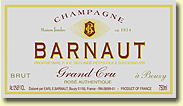 NV
E. Barnaut Rosé Authentique
NV
E. Barnaut Rosé Authentique
(90% Pinot Noir, 10% Charonnay;
Majority if not all grapes from Bouzy; Saignee Method; Disgorged
2006; $35-45 US)
I have an on and off relationship with E. Barnaut. Sometimes
the bottles are on and sometimes they are off. I’ve never been
able to figure it out. I can grab a couple bottles of the same
cuvee from the same disgorgement and they will be completely
different animals. I have no clue why, but quality control has
lacked in the past. I’ve had the Rosé before and sometimes it
has been a very nice wine with a nice meatiness to it along with
a little earth. Other times it has been quite laden with
overpowering earth and dirt . Some have called this similar to a
Burgundy as it isn’t a fruit bomb, shows what they call
“terroir,” and can be a bit of a crapshoot in what you are
getting. So how did it fair this time?
The nose is definitely showing some youth as dry candied green
apples and hints of dried cherries waft from the glass. As for
the palate, this can be summed up in one word as, “rustic.” It
is full of earth, dirt, red citrus, fresh picked strawberries
laden in dirt, and dirt covered raspberries. This wine is quite
dry and packs a bit too much earth for me. If I want earth, I
will grab a shovel and a glass and go dig in my back yard. I
guess the Authentique in the wine’s name translates as authentic
French dirt. You can claim “terroir” or “food wine”, but I claim
that you need food to cover up some of the wine’s shortcomings.
I will agree that some wines get better and rise up with food in
a synergistic way. This one gets its holes filled in, but
doesn’t really get better. However, I will agree with
Mike and
Allison Halerz (who I shared this bottle with) that the wine is
much easier for me to enjoy with food.
Overall, this wine is not my style. I need either more meaty,
funky, or fruity notes in my Rosé. Personally, I would score
this wine rather low for my palate, but I think it is well made
(in a dirt filled way) and I can understand others liking this
style more than myself. That is the difference between this wine
and the 2000 Pierre Gimonnet Gastronome reviewed above. I can
understand and see people liking the Barnaut. I cannot
understand anyone liking the Gimonnet. As such, the Barnaut Rosé
gets a higher grade, as I do have respect for the winemaker’s
vision and execution of it. Grade of B-
(80-82 pts). Find this wine
Cheers!
Brad Baker
BACK TO THE TOP
BACK TO BRAD BAKER'S
INDEX PAGE
© Brad Baker


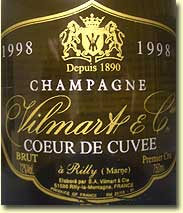 1998 Vilmart Coeur de Cuvee
1998 Vilmart Coeur de Cuvee 2000 Pierre Gimonnet Premier Cru Blanc de Blancs Gastronome
2000 Pierre Gimonnet Premier Cru Blanc de Blancs Gastronome NV Forget-Brimont
Premier Cru Brut Rosé
NV Forget-Brimont
Premier Cru Brut Rosé No, we’re not becoming Spectator pimps; we are only quoting the
back label of this bottle. I have never seen anything like this
before. The back label has the normal producer/importer
information along with the typical alcohol warning that I will
grow five legs and/or spontaneously combust if I get near a car
after having a glass, but it also has the strange Spectator
blurb shown above. I want to hate the wine because of the blurb,
but I figured I should taste it first.
No, we’re not becoming Spectator pimps; we are only quoting the
back label of this bottle. I have never seen anything like this
before. The back label has the normal producer/importer
information along with the typical alcohol warning that I will
grow five legs and/or spontaneously combust if I get near a car
after having a glass, but it also has the strange Spectator
blurb shown above. I want to hate the wine because of the blurb,
but I figured I should taste it first. Marc Hebrart Premier Cru Cuvee de Reserve Brut
Marc Hebrart Premier Cru Cuvee de Reserve Brut NV
Piper-Heidsieck Rosé Sauvage Brut
NV
Piper-Heidsieck Rosé Sauvage Brut 1999 Chartogne-Taillet Millesime Brut
1999 Chartogne-Taillet Millesime Brut 1999 Chartogne-Taillet Fiacre
1999 Chartogne-Taillet Fiacre 2005 Banfi Vigne Regali Rosa Regale Brachetto d’Acqui
2005 Banfi Vigne Regali Rosa Regale Brachetto d’Acqui 2003 Domaine Carneros Brut
2003 Domaine Carneros Brut NV
E. Barnaut Rosé Authentique
NV
E. Barnaut Rosé Authentique